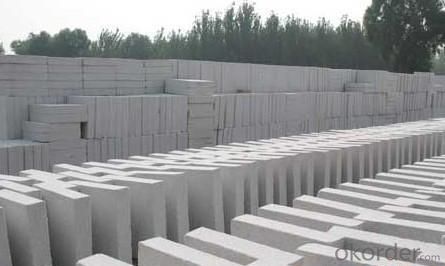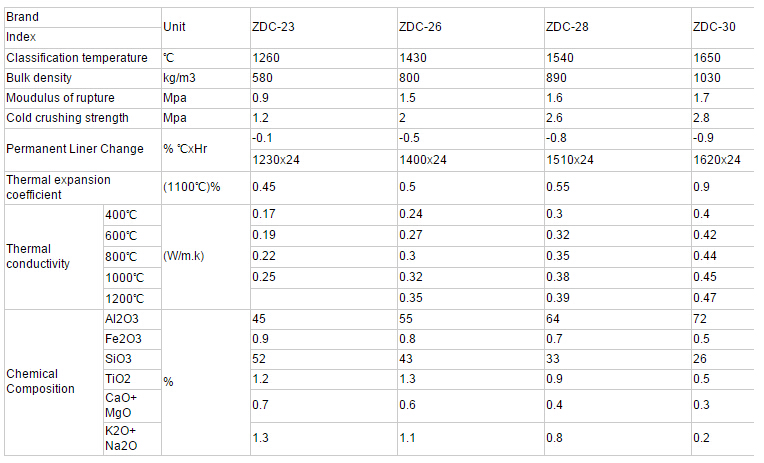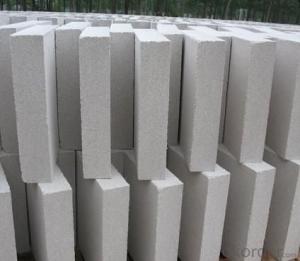Refractory JM Mullite Insulation Brick ZDC-26
- Loading Port:
- Shanghai
- Payment Terms:
- TT OR LC
- Min Order Qty:
- 10 m.t.
- Supply Capability:
- 1000 m.t./month
OKorder Service Pledge
OKorder Financial Service
You Might Also Like
Specifications
light insulation brick
1. refractories
2. silica insulation brick
3. light insulation brick
4. glass furnace
Refractory mullite insulating refractory brick JM 23
Okorder series heat insulation brick
Okorder series thermal insulation brick is an effective, energy saving, low carbon, environmental protection advanced, according to the ASTM standard manufacturing products. Okorder series products are best Li Ning and insulation in all types of industrial furnaces in the metallurgical field, aluminum, petrochemical, electric power and glass ceramic materials. They can be used as part of the working layer of thermal insulation or non - melting. Products have been widely used in the following furnace, achieved satisfactory results.
Application of heat preservation brick
Metallurgical Industry: blast furnace, hot blast furnace, heating furnace, etc..
Petrochemical Industry: ethylene cracking furnace, hydrogen production furnace, primary reformer, heating furnace, etc..
Ceramic industry: roller kiln, kiln, etc..
Glass industry: glass furnace regenerator, etc.
Carbon industry: carbon furnace, etc..
Aluminum electrolysis industry: aluminum reduction cell, etc.
Other industries: tunnel kiln, shuttle kiln, etc..
Advantages of heat insulation brick
Low thermal conductivity: more porosity will bring good thermal insulation effect, energy saving.
High crushing strength: high crushing strength, volume stability.
Low heat storage: small heat storage to absorb more heat, energy-saving effect is obvious.
Gao Chundu: iron, alkali metal impurity content is low.
The precise size: Brick size processing precision, special shape cutting and grinding, accelerate the brickwork.
Insulating brick picture


Common problem solutions
1. What products do you have?
We have all kinds of refractory bricks, refractory casting materials, mortar, cement, ceramic fiber products, etc..
Or you can browse our products to choose what you need.
2. How to control product quality?
With strict quality control system throughout the material selection and production process, we have the quality of refractory materials and ceramic fiber products to meet customer requirements.
From the selection of raw materials, the quality of our control to start. The quality certificate of the raw material is required, each batch of the products are to be tested in the use of the forward line. In the production process, the quality control by the workers, and then each piece of classification, and through the quality supervision and inspection.
3. Can you give me a brief introduction to the application of your product?
My company is mainly engaged in refractories in the steel, cement, glass, ceramics, petrochemical, electric power and other industries.
4. What information do you need if I need you?
In order to select the right products, we will provide us with information, such as the United States, technical data, order quantity, product application, etc..
If you have any questions, please contact us.
Product Description
Light insulation brick
Description
The insulating firebricks are made from high purify raw materials and follows the ASTM C155 classification. These IFB’s contain a carefully graded organic filler which is burned out during firing to give a uniform controlled pore structure and after are machined to precise tolerances on all surfaces.
Features
- Use limit up to 1760°C
- Excellent strength and thermal stability
- Low thermal conductivity
- Low Heat Storage
- High Purity
- Very big range of available sizes and formats
- Very accurate dimensions
Applications
Recommended as hot face and backup insulation in all industries and applications.
Special Shapes
In addition to the standard brick sizes, our bricks are available in pre-machined special shapes as well as Suspended Roof Blocks!
Technical Specification:

- Q:Can insulating fire bricks be used in the construction of thermal oxidizers?
- Yes, insulating fire bricks can be used in the construction of thermal oxidizers. These bricks are designed to withstand high temperatures and provide excellent insulation, making them suitable for applications such as thermal oxidizers, which require efficient heat transfer and containment of high temperatures.
- Q:Can insulating fire bricks be used in the construction of heat exchangers?
- Yes, insulating fire bricks can be used in the construction of heat exchangers. Insulating fire bricks are designed to have excellent thermal insulation properties, which makes them ideal for applications where high temperatures need to be maintained or controlled. Heat exchangers are devices that transfer heat between two or more fluids, and insulation is crucial to prevent heat loss or gain during the process. Using insulating fire bricks in the construction of heat exchangers helps to minimize heat transfer to the surrounding environment, resulting in improved energy efficiency and reduced operating costs. The bricks can withstand high temperatures, typically up to 3000°F (1650°C), making them suitable for various heat exchanger applications, including furnaces, boilers, and industrial processes. Additionally, insulating fire bricks are lightweight and have low thermal conductivity, which means they provide effective insulation while being less bulky and more cost-effective than traditional refractory bricks. This makes them easier to handle and install in heat exchanger systems. Overall, the use of insulating fire bricks in the construction of heat exchangers offers several advantages, including enhanced thermal insulation, improved energy efficiency, and reduced costs.
- Q:Do insulating fire bricks require regular maintenance?
- Insulating fire bricks are engineered to endure high temperatures and resist deterioration, thereby obviating the need for routine upkeep. Crafted from robust materials with exceptional insulating capabilities, they are impervious to wear and tear. Nevertheless, a periodic examination to detect any cracks, chips, or indications of impairment is imperative. In the event that damage is discovered, immediate repairs are essential to guarantee the bricks' optimal functionality. Moreover, regular cleansing of the bricks aids in the elimination of debris or residue accumulation, which can impede their insulating qualities. In summary, although infrequent maintenance is required for insulating fire bricks, periodic inspections and intermittent cleansing are advised to uphold their durability and efficacy.
- Q:Do insulating fire bricks have a low density?
- Insulating fire bricks possess a lower density in comparison to alternative brick types. Such bricks are engineered to embody a porous structure, thereby facilitating heat transfer reduction and insulation enhancement. The lightweight characteristic of these insulating fire bricks enables them to furnish efficient thermal insulation. Consequently, they prove apt for a multitude of applications wherein heat preservation and energy efficiency hold paramount significance, such as kilns, furnaces, and fireplaces.
- Q:Can insulating fire bricks be used in the construction of lime production kilns?
- Yes, insulating fire bricks can be used in the construction of lime production kilns. Lime production kilns require high temperatures to convert limestone into lime, and insulating fire bricks are known for their ability to withstand and retain high temperatures. These bricks have high insulating properties, allowing the kiln to reach the desired temperature quickly and efficiently, while also minimizing heat loss during the production process. Insulating fire bricks are also lightweight and easy to handle, making them suitable for use in the construction of lime production kilns. Additionally, these bricks have good thermal shock resistance, meaning they can withstand rapid temperature changes without cracking or breaking, which is crucial in the kiln environment. Overall, the use of insulating fire bricks in the construction of lime production kilns can help optimize the efficiency and effectiveness of the lime production process.
- Q:If there is a main component of cenosphere light insulating brick.
- Before 2003 because the price is cheaper to do so cenosphere light heat insulation brick is generally used zeeospheres. After 2003 basically replaced by fly ash and other lightweight refractory material, but some high-grade light brick or floating beads.
- Q:Do insulating fire bricks have good mechanical strength?
- Yes, insulating fire bricks have good mechanical strength. They are specifically designed to withstand high temperatures and provide excellent thermal insulation while maintaining their structural integrity.
- Q:Are insulating fire bricks suitable for use in thermal power plants?
- Yes, insulating fire bricks are suitable for use in thermal power plants. Insulating fire bricks are designed to have low thermal conductivity, which means they can effectively retain heat and prevent heat loss. In thermal power plants, where high temperatures are generated, insulating fire bricks can be used as linings for furnaces, boilers, and other equipment to provide thermal insulation and increase energy efficiency. Additionally, these bricks are resistant to high temperatures and can withstand thermal shocks, making them ideal for use in environments with extreme heat. By using insulating fire bricks in thermal power plants, operators can reduce heat loss, increase the overall efficiency of the plant, and improve the durability and lifespan of the equipment.
- Q:What are the disadvantages of using insulating fire bricks?
- Potential users should be aware of several disadvantages when using insulating fire bricks. Firstly, compared to other types of bricks, insulating fire bricks have a relatively low compressive strength. This means they may not be suitable for applications that require high structural integrity or load-bearing capacity. Excessive pressure or heavy loads can cause the bricks to crack or break, compromising the overall stability of the structure. Secondly, insulating fire bricks are more prone to erosion and wear compared to other types of bricks. They have a lower resistance to abrasion and chemical attack, which means they may deteriorate more quickly when exposed to harsh environments or aggressive substances. This can result in the need for more frequent maintenance or replacement of the bricks, leading to increased costs and efforts. Another drawback of insulating fire bricks is their relatively high thermal conductivity. Although they are designed to provide insulation and reduce heat transfer, they still allow some heat to pass through. This can be problematic in applications where maximum thermal insulation is required, as it may lead to heat loss and decreased energy efficiency. Furthermore, insulating fire bricks are typically more expensive than regular bricks or other insulation materials. Their specialized composition and manufacturing process contribute to higher production costs, which are then passed on to the consumer. This can make them less cost-effective for certain applications, especially when cheaper alternatives with similar insulation properties are available. Lastly, insulating fire bricks are generally not suitable for use in direct contact with high-temperature flames or extreme thermal conditions. While they can withstand high temperatures, there is a limit to their heat resistance. Exceeding this limit can cause the bricks to crack or even disintegrate, rendering them ineffective as insulation and potentially compromising the safety of the surrounding environment. In conclusion, while insulating fire bricks offer advantages in terms of thermal insulation and lightweight properties, they also have several disadvantages that should be taken into consideration. These include low compressive strength, susceptibility to erosion and wear, relatively high thermal conductivity, higher cost compared to other materials, and limited tolerance to extreme thermal conditions.
- Q:Can insulating fire bricks be used in electric furnaces?
- Yes, insulating fire bricks can be used in electric furnaces. These bricks are specifically designed to withstand high temperatures and provide excellent insulation, making them suitable for use in electric furnaces where heat retention is crucial.
1. Manufacturer Overview |
|
|---|---|
| Location | |
| Year Established | |
| Annual Output Value | |
| Main Markets | |
| Company Certifications | |
2. Manufacturer Certificates |
|
|---|---|
| a) Certification Name | |
| Range | |
| Reference | |
| Validity Period | |
3. Manufacturer Capability |
|
|---|---|
| a)Trade Capacity | |
| Nearest Port | |
| Export Percentage | |
| No.of Employees in Trade Department | |
| Language Spoken: | |
| b)Factory Information | |
| Factory Size: | |
| No. of Production Lines | |
| Contract Manufacturing | |
| Product Price Range | |
Send your message to us
Refractory JM Mullite Insulation Brick ZDC-26
- Loading Port:
- Shanghai
- Payment Terms:
- TT OR LC
- Min Order Qty:
- 10 m.t.
- Supply Capability:
- 1000 m.t./month
OKorder Service Pledge
OKorder Financial Service
Similar products
New products
Hot products
Related keywords



























